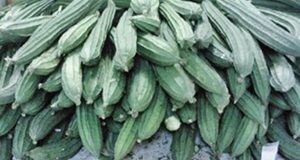Abstract
Luffa is the genus name of several tropical and subtropical plants in the cucumber family. Alternatively spelled “Loofa” or “Loofah,” the name is derived from the plant’s use as a material for sponges and dish cloths for bathing and cleaning dishes. This 6-page fact sheet describes the two types of Luffa, how to cultivate them, and what they can be used for. Written by Yucong Xie, Guodong Liu, Yuncong Li, and Kati Migliaccio, and published by the Horticultural Sciences Department, September 2016.
HS1285/HS1285: Luffa—an Asian Vegetable Emerging in Florida (ufl.edu)
References
Capinera, J. L. 2014. Vegetable Leafminer, Liriomyza sativae Blanchard (Insecta: Diptera: Agromyzidae). EENY255. Gainesville: University of Florida Institute of Food and Agricultural Sciences. Accessed on September 18, 2019. http://edis.ifas.ufl.edu/in507
Davis J. M. 1994. "Luffa Sponge Gourd Production Practices for Temperate Climates." HortScience 29(4): 263-266. https://doi.org/10.21273/HORTSCI.29.4.263
Davis, J. 2008. Commercial Luffa Sponge Gourd Production. NC State University & A&T State University Cooperative Extension. Accessed on September 18, 2019. http://content.ces.ncsu.edu/commercial-luffa-sponge-gourd-production
Dhiman, K. A, Gupta, D. K. Sharma, N. S. Gill, and A. Goyal. 2012. "A Review on the Medicinally Important Plants of the Family Cucurbitaceae." Asian Journal of Clinical Nutrition 4(1): 16-26. https://doi.org/10.3923/ajcn.2012.16.26
Egel, D. S., R. Weinzierl, P. O'Malley, R. Cloyd, B. Hutchinson, J. Pinero, and C. Welty. 2016. "Asian Vegetables." Midwest Vegetable Production Guide for Commercial Growers. Purdue University.
Filipowicz, N. H. and H. Schaefer. 2014. "Revisiting Luffa (Cucurbitaceae) 25 Years After C. Heiser: Species Boundaries and Application of Names Tested with Plastid and Nuclear DNA Sequences." Systematic Botany 39(1): 205-215. https://doi.org/10.1600/036364414X678215
Jianhu S., M. X. Yi, X. D. Huang, S. W. Zhou, and R. Dong. 2012. "Mechanical properties of luffa sponge." Journal of the Mechanical Behavior of Biomedical Materials 15:141-152. https://doi.org/10.1016/j.jmbbm.2012.07.004
Lee, S. and J. G. Yoo. 2006. "Method for preparing transformed luffa cylindrica Roem." World Intellectual Property Organization.
Liu, G. D., E. H. Simonne, K. T. Morgan, G. J. Hochmuth, M. Ozores-Hampton, and S. Agehara. 2019. Chapter 2. Fertilizer Management for Vegetable Production in Florida. CV296. Gainesville: University of Florida Institute of Food and Agricultural Sciences. Accessed on September 18, 2019. http://edis.ifas.ufl.edu/cv296 https://doi.org/10.32473/edis-cv296-2020
Oboh, I. O., and E. O. Aluyor. 2009. "Luffa cylindrica - an emerging cash crop." African Journal of Agricultural Research 4 (8): 684-688.
Partap, S. A. Kumar, N. K. Sharma, and K. K. Jha. 2012. "Luffa Cylindrica: An important medicinal plant." J. Nat. Prod. Plant Resour. 2 (1):127-134.
Stephens, J. M. 2018. Gourd, Luffa-Luffa cylindrica (L.) Roem., Luffa aegyptica Mill., and Luffa acutangula (L.) Roxb. HS604. Gainesville: University of Florida Institute of Food and Agricultural Sciences. Accessed September 18, 2019. http://edis.ifas.ufl.edu/mv071
USDA Natural Resources Conservation Service. "Luffa acutangula (L.) Roxb." Accessed on September 18, 2019: http://plants.usda.gov/core/profile?symbol=LUAC2
USDA Natural Resources Conservation Service. "Luffa acutangula (L.) Roxb." Available online at: http://plants.usda.gov/core/profile?symbol=LUAC2. Accessed on September 18, 2019
Zong, R. J., C. Marita, and L. M. Leonard. 1993. "Angled luffa, bitter melon, fuzzy melon, yard-long bean-postharvest handling of Asian specialty vegetables under study." California Agriculture 47(2):27-29 https://doi.org/10.3733/ca.v047n02p27

